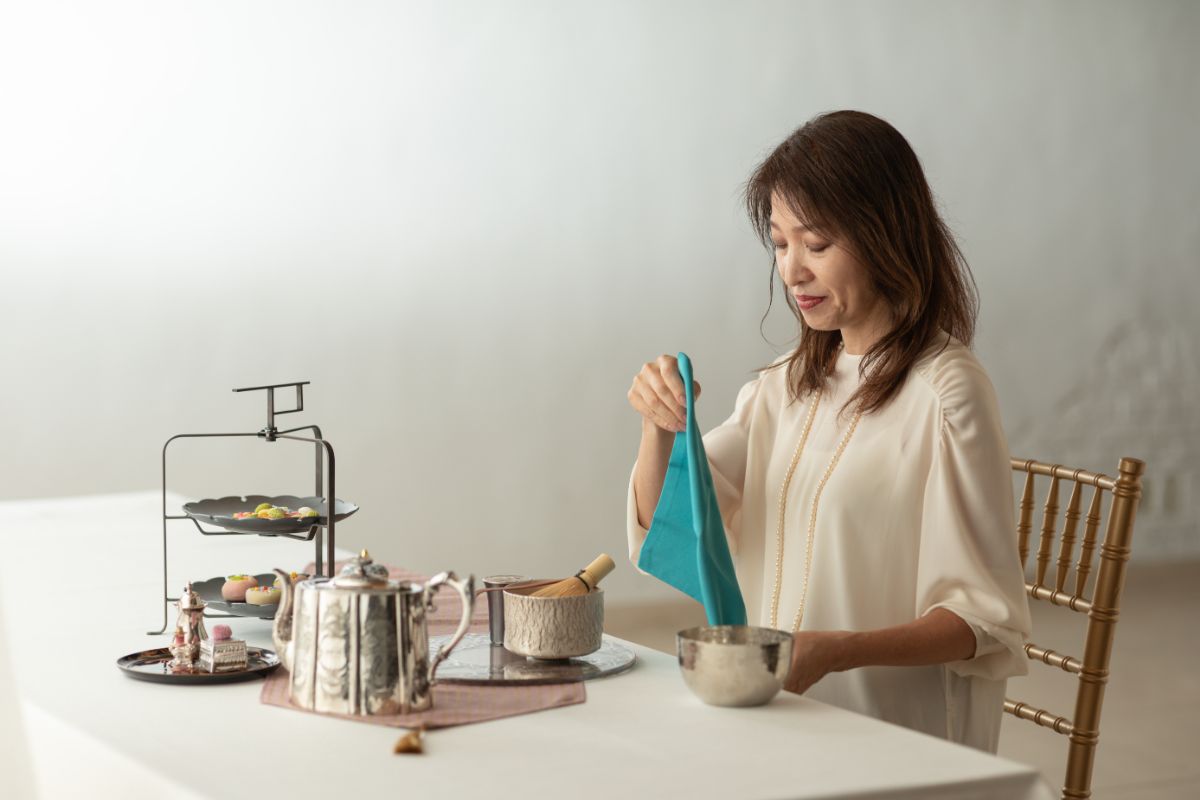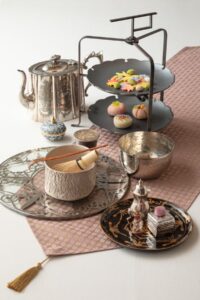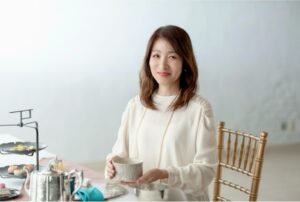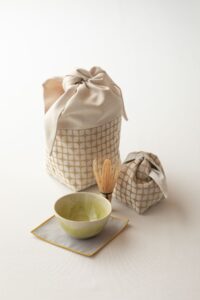Modern-style tea ceremony master; Makiko Mizoroki – On the synergy between eterble and tea ceremony, and her thoughts on eterble 3rd collection.
The INTERVIEW series seeks advice from various professionals on tips for enriching daily life while naturally participating in sustainable practices. In this volume, we speak with modern-style tea ceremony master Makiko Mizoroki. We asked her about the activities of the modern-style tea ceremony she leads, as well as new tea ceremony-related products she supervised for the 3rd collection of eterble, which will be released this fall.
ーCould you tell us about the “modern-style tea ceremony” and its activities?ー
Mizoroki I’ll begin by talking about my first encounter with matcha. When I was a child, my grandmother would wear a kimono and prepare matcha for us in everyday life. She wasn’t a tea master, but that peaceful scene left a lasting impression on me. Later, in my twenties, I wanted to learn how to wear a kimono by myself, so I started taking kimono lessons. My kimono instructor also taught the tea ceremony, which gave me the opportunity to start learning it.
The tea ceremony is a world that highly values tradition. Many people might think of it as something with high barriers to entry. However, just like the comfort I felt as a child, I wanted people to enjoy a “tea life” that allows them to clear their minds and enrich their hearts in daily life. That’s why five years ago, I began promoting the idea of the Art de Vivre, which incorporates the tea ceremony and Japanese aesthetics into everyday life and lifestyle. I call this the “modern-style tea ceremony.”
In addition to the classes I offer, I also provide guidance on matcha for cafes and companies, work as a table coordinator, collaborate on events that involve Japanese incense culture, and more. Personally, I also enjoy communicating through small tea utensils while traveling, embracing the tea ceremony’s spirit of cherishing once-in-a-lifetime encounters.
* Art de Vivre is a lifestyle concept meaning “the art of living” or “the aesthetics of life.” It refers to a way of living where one finds beauty in everyday scenes, much like the French ethos of valuing a life rich in sensitivity.

ーWhen hosting a tea gathering, there are many details to consider; from meticulous preparation to hospitality on the day of the event. Are there any particular things you keep in mind?ー
Mizoroki In the tea ceremony, there is a saying, “Ichigo Ichie,” meaning each tea gathering is a once-in-a-lifetime event. Even if you have the opportunity to sit with the same people again, each tea gathering is unique. This reminds us to wholeheartedly devote ourselves to hospitality for each occasion. Since no two gatherings are the same, I value cherishing each tea gathering and encounter with sincerity.
In modern-style tea ceremonies, we base our gatherings on the tea ceremony’s principles of “Mitate” and “Shuhari,” creating themes and settings based on the season. Combining Japanese aesthetics with modern style, we blend not only Japanese culture but also European, Asian, and contemporary art to create a sense of unity in the gathering. We strive to serve our guests a delightful cup of tea, giving our best efforts.
We also emphasize making the tea ceremony accessible in everyday life. I suggest ways to incorporate it, like using your home’s interior and tableware as tea utensils, or using table settings that make the ceremony easy and enjoyable for all.
* Mitate refers to the act of “reimagining” or “reinterpretation” in a creative way. In the tea ceremony, it can mean using objects not originally intended for tea as tea utensils, or arranging a tea space in a way that evokes a new perspective or feeling.
* Shuhari is a Japanese philosophy of learning and mastery, composed of three different thoughts which are Shu (means “to obey” or “to preserve”), Ha (means “to break”), and Ri (means “to separate”).
ーCould you tell us how you came across eterble? And how do you perceive the brand’s unique identity as a sustainable tableware brand?ー
Mizoroki I learned about the brand through my encounter with eterble’s creative director, Hayama-san.
In table tea ceremonies, the coordination begins with draping a cloth over the table. I learned that eterble’s product lineup includes tablecloths made from recycled polyester fabric, using their company’s waste cloth as raw material. My first impression was that it’s a unique and highly intriguing brand.
The tea ceremony itself is actually quite sustainable. It’s a culture that has been passed down for about 450 years, with many tools and utensils being inherited over time. Especially tea utensils — even a single tea bowl often involves the craftsmanship of many artisans and focuses on natural, organic materials. We enjoy the aging of these utensils and repair them using techniques like kintsugi (gold joinery) to extend their use.
I felt that the culture of the tea ceremony shares similarities with eterble’s brand concept and product development. I was also deeply impressed by their focus on the process of transforming and connecting things to create something new. Furthermore, the products themselves are captivating. They evoke the elegance of a tea room, with their calm, muted colors… From the fabric, I felt a beauty of “subtraction,” and I thought it would be a great fit for modern-style tea ceremonies.

ーIn eterble’s 3rd collection, you supervised new products designed for wrapping and carrying tea utensils. Could you share your thoughts on their usability and design?ー
Mizoroki In the tea ceremony, we use items like fukuro-mono (pouches for storing and protecting utensils) and shifuku (silk covers for tea utensils). Also, when we attend tea gatherings, before entering the tea room, we wrap our belongings in a furoshiki cloth and hand them over. So, the act of wrapping and covering is a daily practice.
For the 3rd collection, I supervised items like a tea bowl pouch, a case for tea scoops, hedate (cushioning to prevent utensils from bumping), and a carrying bag for tea utensils, all inspired by tea ceremony bags.
I was involved in fabric selection from the beginning, and there were many types of sample fabrics prepared, showing me the complexity of product development. After consulting with director Hayama-san, I suggested colors and patterns that would coordinate well with modern tea utensils.
Mizoroki Among the new products, the tea bowl pouch was modeled after an otsu-bukuro, a pouch for storing tea containers. Its long ties allow you to wrap bowls of various sizes. It can also be used as a shoulder bag. The hedate was also designed to serve not only its original purpose but also as a coaster or base for interior items. The flexibility in size and multiple uses are appealing features of these new products.
Additionally, the fabric patterns reverse colors when viewed from the other side, adding an element of surprise and joy when unwrapping the package. This hidden charm reminds me of the sophistication of hakkake, the unseen lining of a kimono. The design is simple at first glance but has depth… It’s characterized by this chic, modern aesthetic.
While these products are based on the tea ceremony, their versatile sizes and uses, along with their refined designs that blend well with modern life. I hope many people will enjoy the items.
ーWhat are your expectations for eterble moving forward?ー
Mizoroki Having been involved in the development of eterble’s products, one thought crossed my mind. While practicing craftsmanship that connects to the next generation, eterble is developing tableware that harmonizes with daily life, which feels reminiscent of Sen no Rikyū. Rikyū valued using simple, unembellished tools that made the most of nature, recognizing essential value and beauty in simplicity. I feel this philosophy is closely related to sustainability.
eterble’s products use recycled materials while offering elegant, simple designs that enhance daily life. I hope the new products can help create special moments and spaces, whether in daily life or on trips, in both ordinary and extraordinary settings.
Profile

Makiko Mizoroki
Modern-style tea ceremony master, a head of “Modern-style Tea Ceremony” , with 35 years of experience in Edo Senke tea ceremony.
Modern-style Tea Ceremony https://www.jmodernstyle.com
Instagram https://www.instagram.com/makiko_modernstylesado
